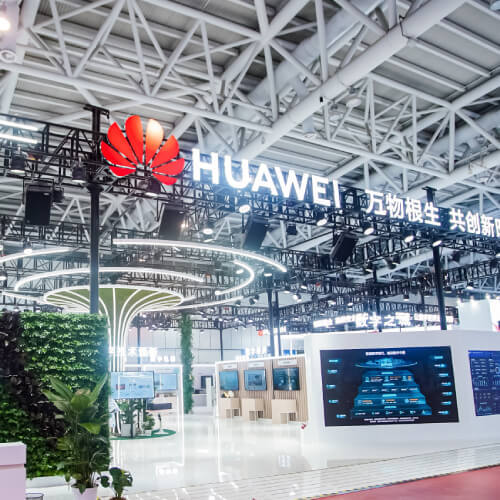Huawei gained 12K employees last year in R&D splurge
The Chinese equipment giant hired 7,000 R&D professionals last year as it fought back against US sanctions.

Being able to sacrifice profit margins in a massive long-term bet is a luxury few major Western corporations enjoy. Not so Huawei. The Chinese equipment vendor has been in a fight for survival as successive US presidents fire torpedoes at its supply chain, aiming to cut it off from vital components. Huawei's latest response, as revealed in the annual report it published last week, is to hire thousands of reinforcements, mainly in research and development (R&D).
The company's workforce grew by an astonishing 12,000 employees last year at a time when better-performing US tech giants were slashing jobs. Data supplied by Huawei shows the increase included the addition of 7,000 jobs in R&D, bringing the total there to 114,000. That means about 55% of all Huawei staff now work in this area.
Unsurprisingly, the company's R&D budget has soared to around 161.5 billion Chinese yuan (US$23.4 billion), roughly 13% more than it spent in 2022. Spending now accounts for as much as a quarter of Huawei's entire sales, a much higher share than Western peers invest in R&D each year. For comparison, Sweden's Ericsson spent about 47.3 billion Swedish kronor ($4.6 billion) on R&D in 2022, equal to 17% of sales, while the budget at Finland's Nokia was just less than €4.6 billion ($5 billion), or 18% of revenues.
Figure 1:  Huawei founder Ren Zhengfei says the company has been redesigning components.
Huawei founder Ren Zhengfei says the company has been redesigning components.
(Source: World Economic Forum on Flickr CC2.0)
Both Nordic vendors have also been cutting or preparing to cut jobs even as they boost R&D spending. Nokia's average annual headcount shrank by around 1,000 last year and the company employs 5,000 fewer people than it did in 2020. CEO Pekka Lundmark has previously said he aims to have a workforce of between 80,000 and 85,000 people when the latest restructuring is finished. Last year, its annual average was 86,896, according to the latest annual report.
As for Ericsson, staff numbers have mushroomed following earlier layoffs to 105,529 at the end of 2022, about 4,200 more people than it employed a year before. Takeover activity, including the recent $6.2 billion acquisition of Vonage, has added thousands of people to the payroll. But Ericsson now plans to cut about 8,500 jobs, a move that will reduce headcount to the level it was at before late 2019, as it tries to protect margins that have recently come under pressure.
No worries
There are no such apparent worries for Huawei. The numbers published last week show that its operating margin shrank to 6.6%, from 19.1% in 2021, due to higher costs including the sizeable investment in R&D. Huawei's net profit, meanwhile, tumbled to as little as RMB35.6 billion ($5.2 billion), a drop of 69% compared with the year-earlier figure.
The revelation comes after Ren Zhengfei, Huawei's founder, was reported to have said the company has replaced about 13,000 components and redesigned more than 4,000 circuit boards in response to US sanctions. The biggest impact of those has been to deny Huawei access to chips made by Taiwan's TSMC, which produces the bulk of the world's most advanced semiconductors.
That has mainly hurt Huawei's huge devices business, which now lacks the cutting-edge chips it needs to compete against the likes of Apple and Samsung in the smartphone market. Sales at this consumer unit dropped 12% last year, to about RMB214 billion ($31 billion), after halving in 2021.
But Huawei's networks business is not immune. While sales there crept up 1% last year, to roughly RMB284 billion ($41 billion), the 5-nanometer chips considered cutting edge in smartphones just a couple of years ago are now being included in the latest radio access network equipment, said Tommi Uitto, the head of Nokia's mobile network business group, during a conversation with Light Reading at this year's Mobile World Congress. Unfortunately for Huawei, these chips are currently available only from foundries that use US equipment or software. That means they cannot sell to Huawei without suffering US penalties.
Figure 2: Headcount at Ericsson, Huawei and Nokia  (Source: companies)
(Source: companies)
Other governments have joined the blockade. Most notably, the Netherlands has denied ASML licenses to sell its most advanced chip-making tools to China, hindering Chinese efforts to produce cutting-edge chips at home. This is critical because ASML enjoys a monopoly in the market for extreme ultraviolet lithography (EUV), an advanced system for etching circuitry onto silicon wafers. Without EUV, producing chips based on sub-7-nanometer process nodes is said to be difficult if not impossible.
Experts are skeptical that Huawei and China will be able to find alternatives or develop a homegrown chips supply for many years. Yet Huawei has coped better than many had expected. Much of its network equipment does not require cutting-edge chips, and stockpiling may have helped to support more advanced product lines. To compensate for the downturn at its gadgets unit, Huawei has prioritized expansion into areas less dependent on hardware. Many of these fall under the umbrella of its fast-growing enterprise business, whose sales rose 30% last year, to RMB133 billion ($19 billion).
What will unnerve Huawei's opponents is that it can still dramatically outspend its Western rivals without incurring losses, hiring thousands of people as companies outside China are forced to prune headcount. Having such a vast market on its Shenzhen doorstep has obviously helped, but Huawei still has a major presence in countries such as Germany, where it counts all three national operators as clients. Tripping it up has turned out to be much harder than US authorities had calculated.
Related posts:
— Iain Morris, International Editor, Light Reading
About the Author(s)
You May Also Like











